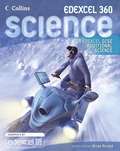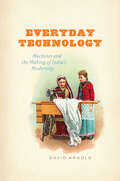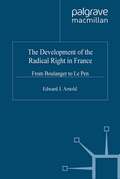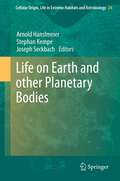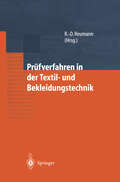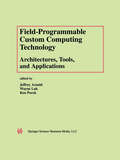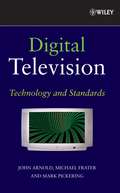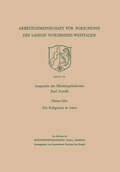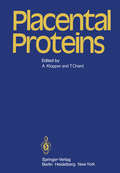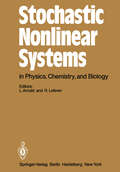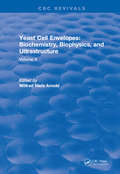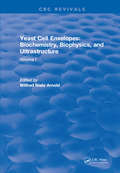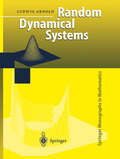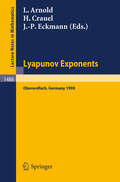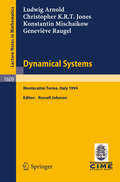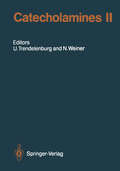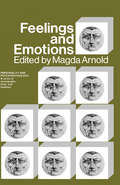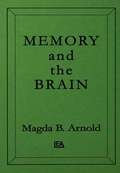- Table View
- List View
GCSE Science for Edexcel — ADDITIONAL SCIENCE STUDENT BOOK (PDF)
by Brian ArnoldPart of Collins' Edexcel GCSE Sciences series, this student textbook has been written in consultation with Edexcel. The student textbook offers highly stimulating material, packed with real-world science and fully differentiated to engage and cater for all students.
Everyday Technology: Machines and the Making of India's Modernity (science.culture)
by David ArnoldIn 1909 Mohandas Karamchand Gandhi, on his way back to South Africa from London, wrote his now celebrated tract Hind Swaraj, laying out his vision for the future of India and famously rejecting the technological innovations of Western civilization. Despite his protestations, Western technology endured and helped to make India one of the leading economies in our globalized world. Few would question the dominant role that technology plays in modern life, but to fully understand how India first advanced into technological modernity, argues David Arnold, we must consider the technology of the everyday. Everyday Technology is a pioneering account of how small machines and consumer goods that originated in Europe and North America became objects of everyday use in India in the late nineteenth and early twentieth centuries. Rather than investigate “big” technologies such as railways and irrigation projects, Arnold examines the assimilation and appropriation of bicycles, rice mills, sewing machines, and typewriters in India, and follows their impact on the ways in which people worked and traveled, the clothes they wore, and the kind of food they ate. But the effects of these machines were not limited to the daily rituals of Indian society, and Arnold demonstrates how such small-scale technologies became integral to new ways of thinking about class, race, and gender, as well as about the politics of colonial rule and Indian nationhood. Arnold’s fascinating book offers new perspectives on the globalization of modern technologies and shows us that to truly understand what modernity became, we need to look at the everyday experiences of people in all walks of life, taking stock of how they repurposed small technologies to reinvent their world and themselves.
Everyday Technology: Machines and the Making of India's Modernity (science.culture)
by David ArnoldIn 1909 Mohandas Karamchand Gandhi, on his way back to South Africa from London, wrote his now celebrated tract Hind Swaraj, laying out his vision for the future of India and famously rejecting the technological innovations of Western civilization. Despite his protestations, Western technology endured and helped to make India one of the leading economies in our globalized world. Few would question the dominant role that technology plays in modern life, but to fully understand how India first advanced into technological modernity, argues David Arnold, we must consider the technology of the everyday. Everyday Technology is a pioneering account of how small machines and consumer goods that originated in Europe and North America became objects of everyday use in India in the late nineteenth and early twentieth centuries. Rather than investigate “big” technologies such as railways and irrigation projects, Arnold examines the assimilation and appropriation of bicycles, rice mills, sewing machines, and typewriters in India, and follows their impact on the ways in which people worked and traveled, the clothes they wore, and the kind of food they ate. But the effects of these machines were not limited to the daily rituals of Indian society, and Arnold demonstrates how such small-scale technologies became integral to new ways of thinking about class, race, and gender, as well as about the politics of colonial rule and Indian nationhood. Arnold’s fascinating book offers new perspectives on the globalization of modern technologies and shows us that to truly understand what modernity became, we need to look at the everyday experiences of people in all walks of life, taking stock of how they repurposed small technologies to reinvent their world and themselves.
Everyday Technology: Machines and the Making of India's Modernity (science.culture)
by David ArnoldIn 1909 Mohandas Karamchand Gandhi, on his way back to South Africa from London, wrote his now celebrated tract Hind Swaraj, laying out his vision for the future of India and famously rejecting the technological innovations of Western civilization. Despite his protestations, Western technology endured and helped to make India one of the leading economies in our globalized world. Few would question the dominant role that technology plays in modern life, but to fully understand how India first advanced into technological modernity, argues David Arnold, we must consider the technology of the everyday. Everyday Technology is a pioneering account of how small machines and consumer goods that originated in Europe and North America became objects of everyday use in India in the late nineteenth and early twentieth centuries. Rather than investigate “big” technologies such as railways and irrigation projects, Arnold examines the assimilation and appropriation of bicycles, rice mills, sewing machines, and typewriters in India, and follows their impact on the ways in which people worked and traveled, the clothes they wore, and the kind of food they ate. But the effects of these machines were not limited to the daily rituals of Indian society, and Arnold demonstrates how such small-scale technologies became integral to new ways of thinking about class, race, and gender, as well as about the politics of colonial rule and Indian nationhood. Arnold’s fascinating book offers new perspectives on the globalization of modern technologies and shows us that to truly understand what modernity became, we need to look at the everyday experiences of people in all walks of life, taking stock of how they repurposed small technologies to reinvent their world and themselves.
Everyday Technology: Machines and the Making of India's Modernity (science.culture)
by David ArnoldIn 1909 Mohandas Karamchand Gandhi, on his way back to South Africa from London, wrote his now celebrated tract Hind Swaraj, laying out his vision for the future of India and famously rejecting the technological innovations of Western civilization. Despite his protestations, Western technology endured and helped to make India one of the leading economies in our globalized world. Few would question the dominant role that technology plays in modern life, but to fully understand how India first advanced into technological modernity, argues David Arnold, we must consider the technology of the everyday. Everyday Technology is a pioneering account of how small machines and consumer goods that originated in Europe and North America became objects of everyday use in India in the late nineteenth and early twentieth centuries. Rather than investigate “big” technologies such as railways and irrigation projects, Arnold examines the assimilation and appropriation of bicycles, rice mills, sewing machines, and typewriters in India, and follows their impact on the ways in which people worked and traveled, the clothes they wore, and the kind of food they ate. But the effects of these machines were not limited to the daily rituals of Indian society, and Arnold demonstrates how such small-scale technologies became integral to new ways of thinking about class, race, and gender, as well as about the politics of colonial rule and Indian nationhood. Arnold’s fascinating book offers new perspectives on the globalization of modern technologies and shows us that to truly understand what modernity became, we need to look at the everyday experiences of people in all walks of life, taking stock of how they repurposed small technologies to reinvent their world and themselves.
Everyday Technology: Machines and the Making of India's Modernity (science.culture)
by David ArnoldIn 1909 Mohandas Karamchand Gandhi, on his way back to South Africa from London, wrote his now celebrated tract Hind Swaraj, laying out his vision for the future of India and famously rejecting the technological innovations of Western civilization. Despite his protestations, Western technology endured and helped to make India one of the leading economies in our globalized world. Few would question the dominant role that technology plays in modern life, but to fully understand how India first advanced into technological modernity, argues David Arnold, we must consider the technology of the everyday. Everyday Technology is a pioneering account of how small machines and consumer goods that originated in Europe and North America became objects of everyday use in India in the late nineteenth and early twentieth centuries. Rather than investigate “big” technologies such as railways and irrigation projects, Arnold examines the assimilation and appropriation of bicycles, rice mills, sewing machines, and typewriters in India, and follows their impact on the ways in which people worked and traveled, the clothes they wore, and the kind of food they ate. But the effects of these machines were not limited to the daily rituals of Indian society, and Arnold demonstrates how such small-scale technologies became integral to new ways of thinking about class, race, and gender, as well as about the politics of colonial rule and Indian nationhood. Arnold’s fascinating book offers new perspectives on the globalization of modern technologies and shows us that to truly understand what modernity became, we need to look at the everyday experiences of people in all walks of life, taking stock of how they repurposed small technologies to reinvent their world and themselves.
Everyday Technology: Machines and the Making of India's Modernity (science.culture)
by David ArnoldIn 1909 Mohandas Karamchand Gandhi, on his way back to South Africa from London, wrote his now celebrated tract Hind Swaraj, laying out his vision for the future of India and famously rejecting the technological innovations of Western civilization. Despite his protestations, Western technology endured and helped to make India one of the leading economies in our globalized world. Few would question the dominant role that technology plays in modern life, but to fully understand how India first advanced into technological modernity, argues David Arnold, we must consider the technology of the everyday. Everyday Technology is a pioneering account of how small machines and consumer goods that originated in Europe and North America became objects of everyday use in India in the late nineteenth and early twentieth centuries. Rather than investigate “big” technologies such as railways and irrigation projects, Arnold examines the assimilation and appropriation of bicycles, rice mills, sewing machines, and typewriters in India, and follows their impact on the ways in which people worked and traveled, the clothes they wore, and the kind of food they ate. But the effects of these machines were not limited to the daily rituals of Indian society, and Arnold demonstrates how such small-scale technologies became integral to new ways of thinking about class, race, and gender, as well as about the politics of colonial rule and Indian nationhood. Arnold’s fascinating book offers new perspectives on the globalization of modern technologies and shows us that to truly understand what modernity became, we need to look at the everyday experiences of people in all walks of life, taking stock of how they repurposed small technologies to reinvent their world and themselves.
The Developing of the Radical Rights in France: From Boulanger to Le Pen
by Edward J. ArnoldThis book traces the origins and evolution of extreme-right wing thought in France from the end of the nineteenth century to the present day. It establishes the presence of an ideological tradition or organicist, exclusive nationalism initiated at the end of the nineteenth century, which adapts itself to the post-First World War and re-emerges forcibly during the Occupation. Elements of this same tradition are present in the modern discourse of the extreme right in post-war France. This helps the student of modern French politics to see movements like the Front National in their historical perspective.
Life on Earth and other Planetary Bodies (Cellular Origin, Life in Extreme Habitats and Astrobiology #24)
by Arnold Hanslmeier, Stephan Kempe and Joseph SeckbachA trio of editors [Professors from Austria, Germany and Israel] present Life on Earth and other Planetary Bodies. The contributors are from twenty various countries and present their research on life here as well as the possibility for extraterrestrial life. This volume covers concepts such as life’s origin, hypothesis of Panspermia and of life possibility in the Cosmos. The topic of extraterrestrial life is currently ‘hot’ and the object of several congresses and conferences. While the diversity of “normal” biota is well known, life on the edge of the extremophiles is more limited and less distributed. Other subjects discussed are Astrobiology with the frozen worlds of Mars, Europa and Titan where extant or extinct microbial life may exist in subsurface oceans; conditions on icy Mars with its saline, alkaline, and liquid water which has been recently discovered; chances of habitable Earth-like [or the terrestrial analogues] exoplanets; and SETI’s search for extraterrestrial Intelligence.
Prüfverfahren in der Textil- und Bekleidungstechnik
by J. Arnold J. H. Dittrich E. Finnimore J. Haase P. Hempel E. Kleinhansl S. Krzywinski R. D. Reumann H. Thomas A. WehlowDie Produktqualität ist ein entscheidender Erfolgsfaktor im wachsenden Wettbewerb. Qualitätssicherung wird daher immer wichtiger, aber auch immer komplexer.In diesem topaktuellen Lehrbuch und Nachschlagewerk vermitteln anerkannte Experten aus dem textilen Prüf- und Messwesen das notwendige Know-how für die sichere Textilprüfung nach den geforderten Qualitätsstandards.Umfassend und alltagsnaho Alle wichtigen Prüfverfahren zur Bestimmung der äußeren Merkmale, der mechanisch-technologischen und der physikalischen Eigenschaften von Textilieno Prüf- und messtechnische Grundlageno Grundlagen der Bestimmung des mechanischen Formänderungsverhaltenso Auswertung textiler Prüfungeno Fragen des QualitätsmanagementsKompakt und praxisgerechto Prüf- und Messverfahren mit Bezug zu den entsprechenden Normen, Regeln und Vorschrifteno Hinweise auf die zukünftige Europa-Normo Klar gegliedert, mit anschaulichen Abbildungen, Tabellen und DiagrammenEin Werk, das Praktiker, Lernende und Wissenschaftler unmittelbar unterstützt - von der Auswahl der geeigneten Verfahren und -geräte für die Textilprüfung über die praktische Umsetzung und die Auswertung der Ergebnisse bis hin zur notwendigen Verifizierung von Innovationen.Jetzt bei Ihrem Buchhändler
Field-Programmable Custom Computing Technology: Architectures, Tools, and Applications
by Jeffrey Arnold Wayne Luk Ken PocekField-Programmable Custom Computing Technology: Architectures, Tools, and Applications brings together in one place important contributions and up-to-date research results in this fast-moving area. In seven selected chapters, the book describes the latest advances in architectures, design methods, and applications of field-programmable devices for high-performance reconfigurable systems. The contributors to this work were selected from the leading researchers and practitioners in the field. It will be valuable to anyone working or researching in the field of custom computing technology. It serves as an excellent reference, providing insight into some of the most challenging issues being examined today.
Digital Television: Technology and Standards
by John Arnold Michael Frater Mark PickeringThe only single, comprehensive textbook on all aspects of digital television The next few years will see a major revolution in the technology used to deliver television services as the world moves from analog to digital television. Presently, all existing textbooks dealing with analog television standards (NTSC and PAL) are becoming obsolete as the prevalence of digital technology continues to become more widespread. Now, Digital Television: Technology and Standards fills the need for a single, authoritative textbook that covers all aspects of digital television technology. Divided into three main sections, Digital Television explores: * Video: MPEG-2, which is at the heart of all digital video broadcasting services * Audio: MPEG-2 Advanced Audio Coding and Dolby AC-3, which will be used internationally in digital video broadcasting systems * Systems: MPEG, modulation transmission, forward error correction, datacasting, conditional access, and digital storage media command and control Complete with tables, illustrations, and figures, this valuable textbook includes problems and laboratories at the end of each chapter and also offers a number of exercises that allow students to implement the various techniques discussed using MATLAB. The authors' coverage of implementation and theory makes this a practical reference for professionals, as well as an indispensable textbook for advanced undergraduates and graduate-level students in electrical engineering and computer science programs.
Ansprache des Ministerpräsidenten Karl Arnold. Die Religionen in Asien (Arbeitsgemeinschaft für Forschung des Landes Nordrhein-Westfalen #28)
by Karl ArnoldPlacental Proteins
by Arnold Klopper and Timothy ChardIn July 1978 a group met in Aberdeen to discuss the whole range of new proteins recently isolated from the human placenta. With the exception of Yuri Tatarinov all the main pioneers in the field were present, and this book arose from the discussions which took place. Each author was asked to bring a written man uscript corresponding to but not necessarily identical with their verbal presentation. Nobody was given a specified remit, for the reason that the subject is so new that it would be impossible to design the meeting or the book in advance. Each speaker was left free to put on display whatever he thought was interesting or important about the newly isolated proteins. Inevitably this has led to much overlap, since everybody tends to follow the same path at first. Nevertheless, we shall probably never achieve so much agreement again. Only Vernon Stevens was set a fixed title out side the immediate field of new placental proteins. This arose from the very exciting possibility that the new proteins could be used to induce an autoimmune state to products of conception and thus serve as the basis for a new method of contraception. There are few findings at present which bear specifically on this proposal, but the experience of Vernon Stevens with hCG could serve as a model of the problems that might be encountered with SP and PAPP-A.
Stochastic Nonlinear Systems in Physics, Chemistry, and Biology: Proceedings of the Workshop Bielefeld, Fed. Rep. of Germany, October 5–11, 1980 (Springer Series in Synergetics #8)
by L. Arnold R. LefeverThis book contains the invited papers of the interdisciplinary workshop on "Stochastic Nonlinear Systems in Physics, Chemistry and Biology" held at the Center for Interdisciplinary Research (ZIF), University of Bielefeld, West Germany, October 5-11, 1980. The workshop brought some 25 physicists, chemists, and biologists - who deal with stochastic phenomena - and about an equal number of mathematicians - who are experts in the theory of stochastic processes - together. The Scientific Commitee consisted of L. Arnold (Bremen), A. Dress (Bielefeld), W. Horsthemke (Brussels), T. Kurtz (Madison), R. Lefever (Brussels), G. Nicolis (Brussels), and V. Wihstutz (Bremen). The main topics of the workshop were the transition from deterministic to stoch astic behavior, external noise and noise induced transitions, internal fluctuations, phase transitions, and irreversible thermodynamics, and on the mathematical side, approximation of stochastic processes, qualitative theory of stochastic systems, and space-time processes. The workshop was sponsored by ZIF, Bielefeld, and by the Universities of Bremen and Brussels. We would like to thank the staff of ZIF and H. Crauel and M. Ehrhardt (Bremen) for the perfect organization and their assistance. In addition, our thanks go to Professor H. Haken for having these Proceedings included in the Se ries in Synergetics. Bremen and Brussels L. Arnold and R. Lefever December 1980 v Contents Part I. Introduction: From Deterministic to Stochastic Behavior On the Foundations of Kinetic Theory By B. Misr~ and I. Prigogine (With 1 Figure) ............................. .
Yeast Cell Envelopes Biochemistry Biophysics and Ultrastructure: Volume II
by Leo H ArnoldA comprehensive review of the yeast cell envelope has not appeared previously and therefore this book is timely. The title of this volume was chosen to reflect the three major areas of contribution to our current understanding of the cell envelope, but we have not attempted to group chapters into subdivisions. The approach was to describe phenomena, to review the literature and to illuminate outstanding problems. It was also attempted to generate working hypotheses which may stimulate further studies. The some of these ideas be of germinal value is of more concern to us than that all of the hypotheses should stand the test of further experimentation.
Yeast Cell Envelopes Biochemistry Biophysics and Ultrastructure: Volume II
by Leo H ArnoldA comprehensive review of the yeast cell envelope has not appeared previously and therefore this book is timely. The title of this volume was chosen to reflect the three major areas of contribution to our current understanding of the cell envelope, but we have not attempted to group chapters into subdivisions. The approach was to describe phenomena, to review the literature and to illuminate outstanding problems. It was also attempted to generate working hypotheses which may stimulate further studies. The some of these ideas be of germinal value is of more concern to us than that all of the hypotheses should stand the test of further experimentation.
Yeast Cell Envelopes Biochemistry Biophysics and Ultrastructure: Volume I
by Leo H ArnoldA comprehensive review of the yeast cell envelope has not appeared previously and therefore this book is timely. The title of this volume was chosen to reflect the three major areas of contribution to our current understanding of the cell envelope, but we have not attempted to group chapters into subdivisions. The approach was to describe phenomena, to review the literature and to illuminate outstanding problems. It was also attempted to generate working hypotheses which may stimulate further studies. The some of these ideas be of germinal value is of more concern to us than that all of the hypotheses should stand the test of further experimentation.
Yeast Cell Envelopes Biochemistry Biophysics and Ultrastructure: Volume I
by Leo H ArnoldA comprehensive review of the yeast cell envelope has not appeared previously and therefore this book is timely. The title of this volume was chosen to reflect the three major areas of contribution to our current understanding of the cell envelope, but we have not attempted to group chapters into subdivisions. The approach was to describe phenomena, to review the literature and to illuminate outstanding problems. It was also attempted to generate working hypotheses which may stimulate further studies. The some of these ideas be of germinal value is of more concern to us than that all of the hypotheses should stand the test of further experimentation.
Random Dynamical Systems (Springer Monographs in Mathematics)
by Ludwig ArnoldThe first systematic presentation of the theory of dynamical systems under the influence of randomness, this book includes products of random mappings as well as random and stochastic differential equations. The basic multiplicative ergodic theorem is presented, providing a random substitute for linear algebra. On its basis, many applications are detailed. Numerous instructive examples are treated analytically or numerically.
Lyapunov Exponents: Proceedings of a Conference held in Oberwolfach, May 28 - June 2, 1990 (Lecture Notes in Mathematics #1486)
by Ludwig Arnold Hans Crauel Jean-Pierre EckmannDynamical Systems: Lectures given at the 2nd Session of the Centro Internazionale Matematico Estivo (C.I.M.E.) held in Montecatini Terme, Italy, June 13 - 22, 1994 (Lecture Notes in Mathematics #1609)
by Ludwig Arnold Christopher K.R.T. Jones Konstantin Mischaikow Genevieve RaugelThis volume contains the lecture notes written by the four principal speakers at the C.I.M.E. session on Dynamical Systems held at Montecatini, Italy in June 1994. The goal of the session was to illustrate how methods of dynamical systems can be applied to the study of ordinary and partial differential equations. Topics in random differential equations, singular perturbations, the Conley index theory, and non-linear PDEs were discussed. Readers interested in asymptotic behavior of solutions of ODEs and PDEs and familiar with basic notions of dynamical systems will wish to consult this text.
Catecholamines II (Handbook of Experimental Pharmacology #90 / 2)
by M. A. Arnold G. Bartholini I. B. Black F. E. Bloom M. J. Brownstein M. E. Conolly G. M. Jonakait G. F. Koob I. J. Kopin J. B. Martin J. M. Masserano M. Palkovits J. L. Reid P. C. Rubin J. M. Saavedra B. Scatton J. A. Schulman A. W. Tank P. R. Vulliet N. Weiner R. M. Weinshilboum B. ZikovicCatecholamines are important transmitter substances in the autonomic and central nervous systems. These two volumes provide a comprehensive presentation of the state-of-the-art of catecholamine research and development in the past 15 years. The volumes present in-depth reviews of topical areas of catecholamine research in which substantial progress has been made and which are of current interest to various theoretical and clinical disciplines. Each topic has been dealt with by an established expert. Clinical subjects of relevant importance are included. Catecholamines are of interest in pharmacology, physiology, biochemistry, as well as in neurology, psychiatry, internal medicine (cardiology, hypertension, asthma), ophthalmology and anesthesiology.
Feelings and Emotions: The Loyola Symposium
by Magda B. ArnoldFeelings and Emotions: The Loyola Symposium covers knowledge in the field of emotion. The book discusses the theories of emotions based on biological considerations; the neural and physiological correlates of feeling and emotion; and cognitive theories of feeling and emotion. The text also describes the psychological approaches to the study of emotion; the mood theory and measurement; as well as the developments related to the search for significant relations between private events and both behavioral and physiological events. The role of feelings and emotions in personality is also encompassed. Psychologists, physiologists, anthropologists, sociologists, biochemists, psychiatrists, and students taking psychology courses will find the book useful.
Memory and the Brain
by Magda B. ArnoldPublished in the year 1984, Memory and the Brain is a valuable contribution to the field of Neuropsychology.
